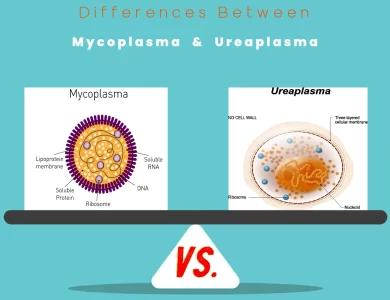Science and Nature
In this engaging corner of knowledge, we embark on a fascinating journey to explore the intricacies and distinctions between various terms, concepts, and phenomena that shape our understanding of the world around us. Join us as we unlock the secrets behind scientific theories, ecological wonders, and so much more.
-

Differences Between Nucleus and Nucleoid
Embarking on a cellular journey reveals the nuanced disparities between the nucleus and nucleoid, pivotal players in the intricate realm of cell biology. In eukaryotic cells, the nucleus takes center stage with its double-membraned elegance, housing linear DNA within chromosomes. Acting as a sophisticated command center, it regulates genetic processes, orchestrating the synthesis of proteins crucial for cellular functions. Conversely, prokaryotic cells feature the nucleoid, an unbounded hub without a membrane, hosting a circular DNA molecule. This streamlined simplicity allows for direct access to genetic material, enabling rapid responses to environmental changes. These distinctions underscore the diverse organizational strategies that contribute to the symphony of life at the cellular level. Explore the structural nuances and functional disparities that define the dynamic interplay between the nucleus and nucleoid, unraveling the fascinating tapestry of cellular diversity.
-

Differences Between DNA and mRNA
Diving into the intricate world of genetics, the distinctions between DNA and mRNA are pivotal in deciphering the code of life. DNA, a stalwart double-stranded helix, anchors itself in the cell nucleus, serving as the archival vault of genetic blueprints. Its stable structure, governed by adenine (A), thymine (T), cytosine (C), and guanine (G), sets the stage for inheritance and long-term storage. In contrast, mRNA emerges as the transient envoy, a single-stranded messenger shuttling between the nucleus and cytoplasm. With uracil (U) in lieu of thymine (T) and a fleeting existence, mRNA takes the lead in protein synthesis before gracefully bowing out through degradation. These disparities extend to their roles, locations, and functions within the cell. DNA's robust stability and involvement in inheritance stand in contrast to mRNA's dynamic yet ephemeral nature, focusing on precise information transmission. As we unveil the intricacies of their genetic dance, we gain insights into the orchestration of cellular processes, from replication and modification to the orchestration of protein synthesis. The genetic tapestry woven by DNA and mRNA exemplifies the elegance and complexity underlying the core processes that define life at the molecular level.
-

Differences Between Sin and Cos
Embarking on a journey through the realm of trigonometry, the distinctions between sine (sin) and cosine (cos) functions come to light. Beyond their fundamental definitions—sin(θ) representing the ratio of opposite to hypotenuse and cos(θ) signifying adjacent to hypotenuse—lies a rich tapestry of contrasts. Graphically, the sine function unfolds as an oscillatory wave, initiating at zero, reaching peaks, descending to troughs, and perpetually repeating. Conversely, the cosine function, while sharing similarities, exhibits a phase shift, starting at its peak and following a cyclical pattern. These nuances extend to real-world applications; sine finds resonance in harmonic motion and AC circuits, while cosine excels in scenarios with phase shifts, prevalent in physics and control systems. The symmetrical disparities, odd nature of sine, and even characteristics of cosine, reverberate through trigonometric identities and mathematical manipulations. Integrating and differentiating these functions brings forth sign alternations, adding another layer to their intricate relationship. As we navigate their shared frequency, periodicity, and delve into Euler's formula, a profound connection emerges, expressing these functions in the language of complex analysis. Unveiling the differences between sine and cosine functions not only enriches our understanding of trigonometry but also illuminates their pivotal roles in diverse mathematical landscapes and real-world scenarios.
-

Difference Between Animal Hair and Human
The comparison between human and animal hair delves into a realm where science meets aesthetics, and functionality blends with cultural significance. Human hair, with its multi-layered structure, undergoes a meticulously orchestrated growth cycle that produces a rainbow of colors. Beyond its cosmetic allure, human hair serves as a sensory organ, a protector against UV radiation, and a canvas for personal expression. On the other side of this follicular coin lies animal hair, a world teeming with diversity. From the lustrous coats of domesticated pets to the insulating fur of wild creatures, animal hair adapts to a myriad of functions. Camouflage, communication, and insulation are just a few roles it plays in the survival and behavior of different species. As we explore these distinctions, we unravel the mysteries of hair's composition, the evolution of its role in our lives, and its ever-evolving place in culture. Whether you're curious about the science behind hair, interested in caring for your own tresses, or pondering the ethics of fur in fashion, the differences between human and animal hair provide a captivating journey through the interconnected realms of biology, culture, and individuality. Join us as we unveil the enchanting tapestry of these hair disparities, unlocking the secrets of what makes each strand unique.
-

Difference Between Myosin and Actin
Actin and Myosin, two pivotal proteins within our cells, are the dynamic duo behind muscle contraction, cellular motility, and a host of other vital functions. Actin, often described as the "thin filament," serves as the structural backbone, participating in cell shape maintenance, immune cell migration, and even the elegant process of cytokinesis. On the other hand, Myosin, the "thick filament," emerges as the energy powerhouse, orchestrating the mechanical force required for muscle contraction and driving the movement of cells and their internal cargo. Intriguingly, Actin and Myosin are not confined to muscle cells; they play integral roles in non-muscle cells, influence our cardiac health, and even contribute to the aging process. Furthermore, these proteins have sparked interest in the realm of drug development, particularly in the context of cardiac medications. Join us on a captivating journey as we unveil the multifaceted world of Actin and Myosin, providing insights into their structural disparities, functions, and their wide-ranging impact on biology, medicine, and beyond.
-

Difference Between Parathyroid and Thyroid
In the world of human anatomy, certain pairs of organs or glands can be confusingly similar in name yet distinctly different in function. Two such glands that often lead to head-scratching moments are the thyroid and parathyroid. Positioned in the neck, these vital endocrine glands play pivotal roles in maintaining overall health, but they do so in unique and divergent ways. Let's embark on a journey to uncover the key disparities between the thyroid and parathyroid, shedding light on their functions, locations, and the profound implications they have on our well-being. The thyroid gland, a butterfly-shaped structure positioned in the front of the neck, is the body's metabolic control center. It regulates our metabolic rate, energy expenditure, and even our body temperature. Producing hormones like thyroxine (T4) and triiodothyronine (T3), the thyroid orchestrates the symphony of bodily processes that keep us going. On the contrary, the parathyroid glands, four small but mighty companions, reside on the posterior surface of the thyroid and focus their efforts on maintaining the delicate balance of calcium in our bloodstream. Parathyroid hormone (PTH) is their tool of choice, ensuring that calcium levels remain within the narrow window required for optimal health. The distinctions between these glands don't end with function and location; they extend to their regulation, development, and even surgical considerations. Understanding the differences between the thyroid and parathyroid is more than a mere exercise in anatomy; it's a journey toward comprehending the intricacies of our body's endocrine system. So, read on to grasp why these differences matter and how they influence your health and well-being.
-

Ureaplasma vs Mycoplasma
In the microscopic realm of bacteria, two intriguing genera, Mycoplasma and Ureaplasma, hold a world of differences that often go unnoticed. Mycoplasma, often referred to as "nature's minimalists," and Ureaplasma, the urea metabolizers, share a common thread – both lack a peptidoglycan cell wall, setting them apart from most other bacteria. Their small size, ranging from 0.2 to 0.8 µm in Mycoplasma and 0.15 to 0.3 µm in Ureaplasma, makes them barely visible to the naked eye. However, it's their unique metabolic capabilities that truly differentiate them. Mycoplasma, despite its small size, cannot metabolize urea, while Ureaplasma is known for its ability to break down urea, producing ammonia as a byproduct. These bacteria also diverge in terms of their ecological niches. Mycoplasma showcases versatility, thriving in environments as diverse as soil, plants, and various animal hosts. In contrast, Ureaplasma primarily colonizes the urogenital tract of humans. Their pathogenic potential further separates them, with some Mycoplasma species causing a range of diseases in humans and animals, while certain Ureaplasma strains are associated with urinary and reproductive infections. Understanding these distinctions is crucial for discerning the roles Mycoplasma and Ureaplasma play in the intricate world of microorganisms. Explore the intricate details of these microbial marvels to grasp their significance in the grand tapestry of microbiology.
-

Chlamydia vs Mycoplasma
In the microscopic realm of infectious agents, Mycoplasma and Chlamydia stand as distinct genera, each with its unique characteristics and impacts on health. "Mycoplasma vs Chlamydia" is a captivating exploration of these microorganisms, delving into the nuances that set them apart. One of the most striking differences lies in their cell walls: Mycoplasma flaunts their minimalistic approach, being devoid of a cell wall, while Chlamydia sports an atypical one. This divergence influences not only their structural integrity but also their response to antibiotics. Beyond the cellular disparities, their genomes paint a vivid contrast. Mycoplasma boasts one of the smallest genomes among cellular life forms, whereas Chlamydia wields a larger and more complex genetic blueprint. These distinctions have significant implications for their nutritional requirements, host tissue preferences, and roles in diseases. Furthermore, the unique reproductive strategies of Mycoplasma through binary fission and Chlamydia's alternation between elementary and reticulate bodies add layers to their differences. Understanding these dissimilarities is paramount, as it affects diagnosis, treatment, and public health. While Mycoplasma infections can lead to outbreaks and respiratory issues, Chlamydia poses a substantial public health challenge as a leading cause of sexually transmitted infections. This exploration takes you on a journey to grasp the captivating "Differences Between Mycoplasma vs Chlamydia," revealing the microbial intricacies that shape the health landscape.
-

Serratia Marcescens vs E. Coli
In the realm of microbiology, the distinctions between bacterial species can be as intriguing as they are vital. This exploration focuses on two remarkable organisms: E. coli and Serratia marcescens. While they might share a few similarities at first glance, a closer examination reveals a world of differences that influence their roles in our ecosystem and health. E. coli, formally known as Escherichia coli, is a versatile bacterium frequently found in the human gut, forming part of our intestinal microbiota. Its taxonomy places it in the Enterobacteriaceae family, and it serves both beneficial and pathogenic roles in human health. Some E. coli strains are notorious for causing foodborne illnesses and extraintestinal infections. In contrast, Serratia marcescens resides in non-human environments, with a penchant for soil, water, and decaying matter. It's part of the Yersiniaceae family and is often recognized for its distinctive red pigment. This opportunistic pathogen can cause infections, primarily in healthcare settings. Understanding the unique characteristics and roles of these bacteria is essential for microbiologists, healthcare professionals, and anyone intrigued by the world of microorganisms. Join us on this journey as we uncover the fascinating differences between E. coli and Serratia marcescens, shedding light on their taxonomy, ecological niches, pathogenicity, and their contributions to biotechnology and medicine.









